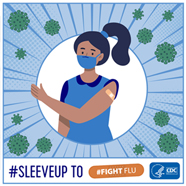Flu Fighter: Xiyan Xu
Meet flu fighter Dr. Xiyan Xu, lead of Virus Reference team in the Virology, Surveillance and Diagnosis branch within the influenza division. Dr. Xu also serves as the deputy director of the Atlanta-based Collaborating Center for Surveillance, Epidemiology, and Control of Influenza, one of six World Health Organization influenza collaborating centers and the largest source of information on human influenza viruses worldwide.
Influenza viruses are among the fastest mutating pathogens known to mankind. Annual influenza epidemics in the United States are responsible for millions of illnesses, hundreds of thousands of hospitalizations and thousands or tens of thousands of deaths each year.
Dr. Xu and her team analyze thousands of influenza viruses collected in the United States and around the world each year to see how they are changing in order to help health officials to select the optimal viruses to use in the production of seasonal influenza vaccines.
Name: Xiyan Xu
Title: Team Lead of Influenza Division Virus Reference team
Location: Atlanta, GA
- What role do you play in fighting flu?
I lead the CDC Influenza Division virus reference team. Our team looks at what seasonal influenza viruses are circulating in people and where they are emerging around the world. We study how the surface proteins of the virus are changing to see if they are similar to current vaccine viruses or have changed so much that we need to identify new vaccine strains. Based on the information gathered, we provide guidance to help make decisions about which viruses should be included in seasonal flu vaccines. In addition, our lab works to create the candidate vaccine viruses that are used for development of flu vaccines. - What is the most rewarding part of your work?
Our work directly impacts important public health decisions—you feel that you are part of important global health decisions. The data we generate is used by leading international public health organizations, like the World Health Organization, to make crucial decisions about vaccines against the four different influenza viruses circulating in our population. - What is the most difficult part of your work?
Flu viruses change so fast! This virus is very difficult, constantly making changes to escape our immunity that make it very difficult to fully understand. We continue to watch and chase this virus, but we can sometimes see a different picture of the viruses even from month to month. Today we have new technology that allows us to know more than ever about this virus, but what we are also discovering is how much there is still to learn. Just as the viruses are changing and evolving, our work to understand and control them needs to adjust and adapt with the new information and technology available. - How serious is flu? What should people know about the risk of flu?
People often can mix up flu with the common cold or another respiratory illness—but the symptoms of flu are often much more severe than a cold—and flu-related complications can be much more serious. This disease is very serious. Every year we see hospitalizations and death from flu—even deaths in young children—and this is something you just don’t want to see. - What would you say to those who are hesitant to get the flu shot?
The best way to prevent flu is vaccination. There is a lot of science behind flu shots—and we continue to learn more every year. This is a vaccine that is different than any other vaccine, because we are dealing with a virus that is constantly changing. Just remember that sometimes you may get the flu despite getting a flu shot, but vaccination can help reduce the severity and length of your illness, and reduce the chance of severe complications. When we look at flu vaccine protection data as a whole, we see the overall positive public health benefits and protection flu vaccines offer.



